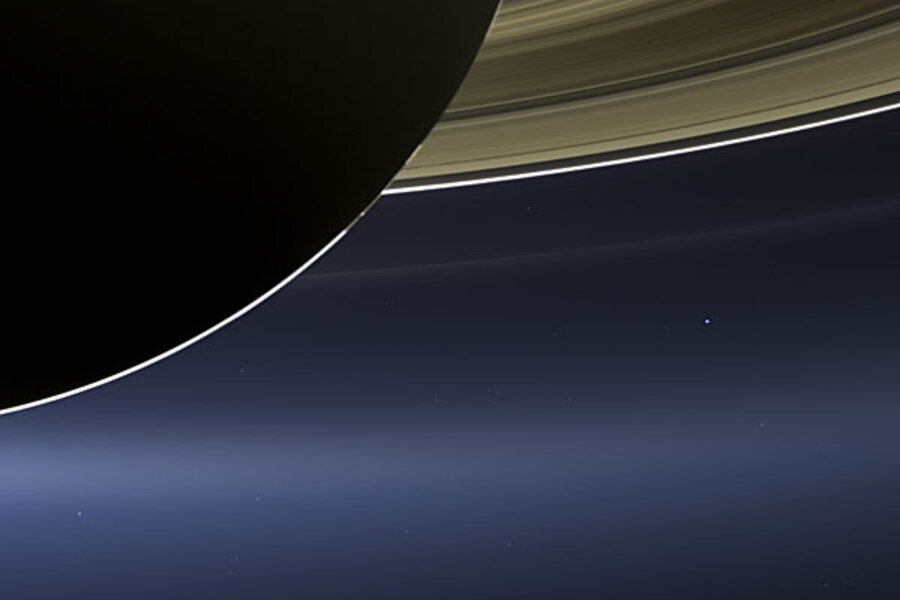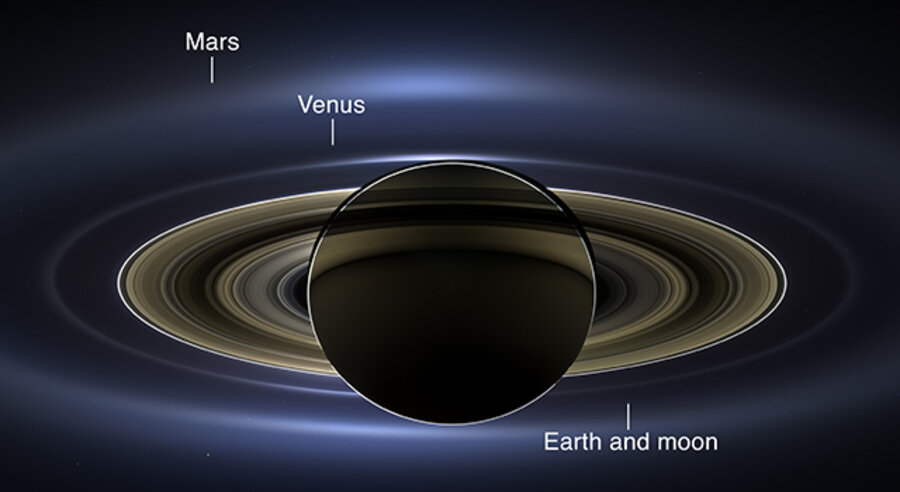Rare photograph of (itty bitty) Earth as seen from Saturn
Loading...
NASA has released the much-awaited, natural-color image of Saturn and some of its neighboring companions, including Earth, as taken by the Cassini probe orbiting Saturn. The panorama, pieced together from photographs taken in July, offers a glimpse of Earth from some 900 million miles afield. And our planet is teeny.
The released photograph is available on the Cassini Imaging team's website, where team leader Carolyn Porco takes Earthlings on a detailed written tour of Saturn's galactic address.
In the photograph, where each pixel represents about 45 miles, we are oriented some 746,000 miles from Saturn and facing a vista some 404,880 miles wide. Seven out of 53 Saturnian moons are visible in their planet’s seven rings. There’s Prometheus, Pandora, Janus and Epimetheus near Saturn’s slim F ring. There’s Enceladus in the bright blue E ring. There’s Tethys, a yellow bulb, and Mimas, just a crescent, wedged between rings.
Then there are more planets, bantam next to Saturn’s hulk. Venus, to Saturn’s upper left, is a bright, white spot. Mars, a pale red dot, is above and to the left of Venus. There are 809 stars captured by Cassini's lens.
We, Earthlings, are perched on a blue dot at Saturn’s lower right.
The cosmic portrait had been months in coming. On July 19, NASA had announced that all the conditions were right for such a picture: on this day, Saturn completely eclipsed the sun, snuffing out the sunlight that could ruin Cassini's delicate sensors. At the same time, Saturn, Earth, and Cassini had arranged themselves so that Earth, proverbial short kid in a class photograph, could be seen in the picture. We are between Saturn’s E and G rings.
The released portrait is an amalgamation of 141 images taken over four hours, selected out of 343 images total. The photograph was then digitally enhanced to pull from the blackness Venus, Mars, Earth, Saturn’s moons, and all the stars in the frame. Most of the objects in the photograph, including Earth, were brightened by 8 times relative to Saturn; some of the stars were brightened by as much as 16 times.
This was also the first time that humans were told in advance that Earth was being put before a camera. So, in what was called NASA’s "Wave at Saturn" campaign, the mission’s team had asked us all to turn out for picture day to wave and smile for the camera in the cosmos. Then it asked for those pictures.
NASA has now amalgamated 1,600 images of Earthlings posing for Cassini, submitted by the public, into a giant mosaic of Saturn.
"In this one magnificent view, Cassini has delivered to us a universe of marvels," said Dr. Porco, in a NASA statement. "And it did so on a day people all over the world, in unison, smiled in celebration at the sheer joy of being alive on a pale blue dot."
In 1990, Voyager 1, the spacecraft now in interstellar space, sent home the first "Pale Blue Dot" image of Earth as it passed Neptune. Earthlings marveled at how insignificant our planet looked. But they also marveled at how people, poised on this pinprick planet, had managed to build a spacecraft, put in out in space, and then retrieve a picture from it.









